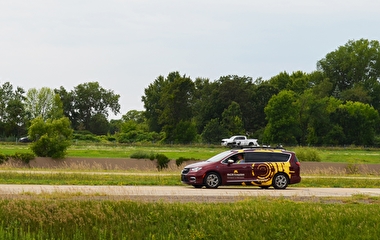On the second day of the visioning workshop, attendees heard from a panel of experts who have experienced AV deployments in their jurisdictions. Panelists from public-sector agencies in Washington, Pennsylvania, and Texas shared their perspectives and offered advice based on their lessons learned.
What have you learned from AV deployments in your areas?
“Our biggest takeaway so far is to focus on collaboration,” said Kristina Holcomb, vice president of strategic planning and development at the Denton County Transportation Authority in Lewisville, Texas. “Everyone has unique needs and resources. [The public sector has] funding opportunities those on the private side don’t have. But the private side can bring a level of expertise we don’t have.”
“It’s important to think about what the lived life with AVs will look like,” said Alexander Pazuchanics, assistant director of the Pittsburgh Department of Mobility and Infrastructure. “The technology is incredibly disruptive in terms of societal norms and the ways cities and regions will operate. [We need to] acknowledge these transitions.”
“AV is not a silver bullet. We have to be careful to not become so enamored with the technology we forget the public policy perspective,” said Roger Millar, secretary of the Washington State Department of Transportation. “People will think they can continue suburban development two hours from downtown because the commute will no longer be a problem. But what really is the technology doing for us? AVs have to blend with walking, biking, and mixed-use transportation.”
What has been the local response to AVs?
“The federal government named Pittsburgh one of 10 AV proving grounds,” explained Pazuchanics. “When bicycle advocacy groups polled the general public, a majority was excited by the technology, as long as AVs obey speed limits and stop signs. I think [following the fatal Uber crash in] Arizona, that might be a different conversation.”
“There’s a fear of the unknown, so we’re focused on community education,” Holcomb said, regarding her agency’s pilot program with Drive.ai that is testing driverless vehicles in Frisco, Texas. “We’ll have chaperones sitting in the passenger seat. They’ll help people on board and answer their questions.”
“[We’re setting] up what I call petting zoos, places where people can see this stuff in action,” Millar said. “We propose local governments team with agencies and AV developers who could bring their technology into a low-speed urban environment where people could kick the tires.”
What advice would you give for how Minnesota should move forward?
“It will be critical to build a sustainable funding strategy to replace revenue losses from things like parking and the gas tax and changes in property tax evaluations,” Pazuchanics said. “If not addressed up front, those revenues will be harder to extract further down the line.”
“Start small and focus on one market,” Holcomb suggested. “Look at case studies [from] other cities. Look at lessons learned and apply them as you’re developing policies. Some cities had AV programs first and then the policies came in, and they didn’t allow for much out-of-the-box thinking. Make sure to form partnerships and have all the right players at the table.”
“You have to get the public health, social equity, environmental, and economic people involved,” Millar emphasized. “AV is a means to an end, and the end is the economic prosperity and quality of life you want to have as a community.”



